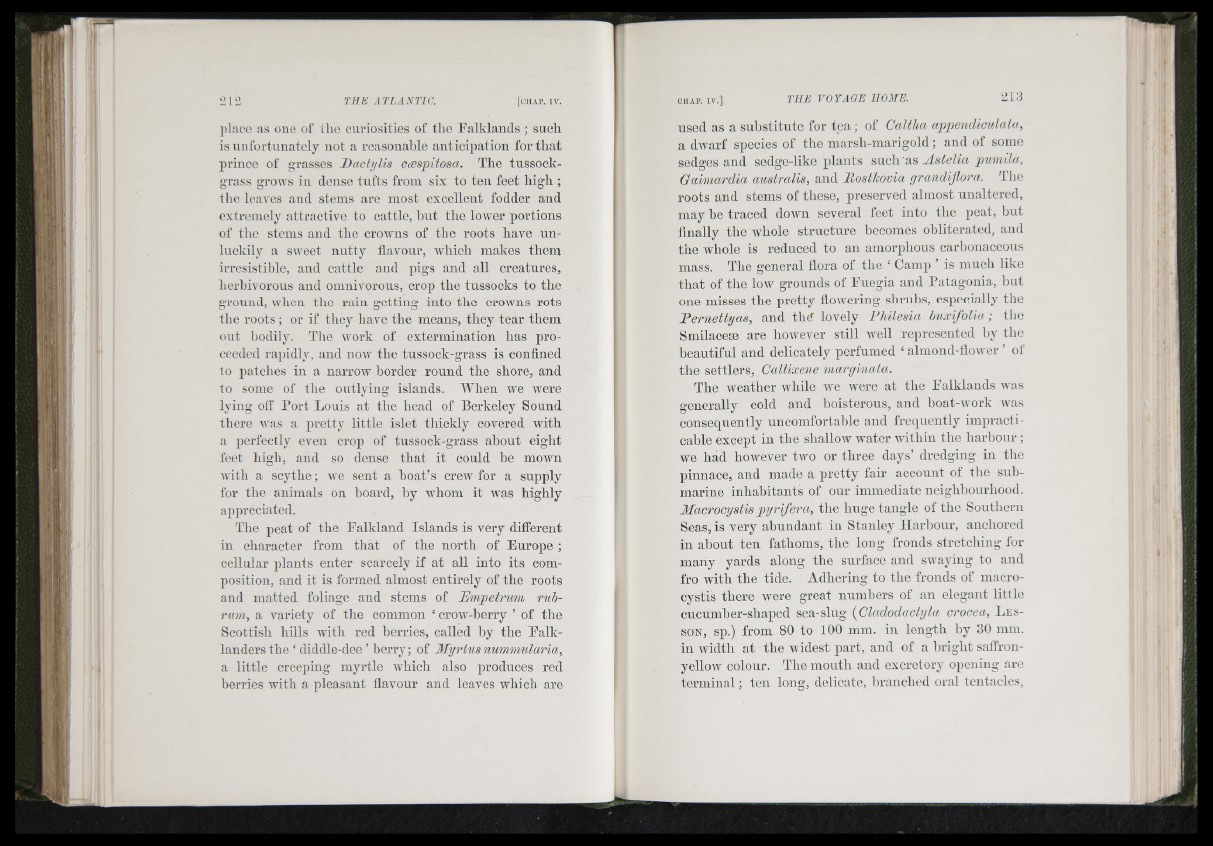
' )
*!
II*
])laeo as one of llie curiosities of tlie Palklands ; such
is nil fortunately not a reasonahle anticipation for th a t
prince of grasses Dactylis cccspitosa. The tussock-
grass grows iu dense tufts from six to ten feet high ;
the leaA'es and stems are most excellent fodder and
extremely attractive to cattle, hut the lower portions
of the stems and the croAvns of the roots have u n luckily
a sweet n u tty flavour, Avhich makes them
irresistible, and cattle and pigs and all creatures,
herbivorous and omnivorous, crop the tussocks to the
ground, when the rain getting into the crowns rots
tbe ro o ts; or if they liaA'e the means, they tear them
out hodily. The ivork of extermination has proceeded
rapidly, and now the tussock-grass is confined
to patches in a narrow border round the shore, and
to some of the outlying islands. AA'hen Ave Avere
lying ofl Port Ponis at the head of Berkeley Sound
there Ai'as a pretty little islet thickly covered with
a perfectly eA'en crop of tussock-grass about eight
feet liigli, and so dense th a t it could be mown
Avith a scythe; we sent a boat’s crew for a supply
for tbe animals on board, by whom it was highly
appreciated.
The peat of the Palkland Islands is very diflerent
in character from th at of the north of Purope ;
cellular plants enter scarcely if a t all into its composition,
and it is formed almost entirely of the roots
and matted foliage and stems of Empetrum ruh-
runi, a variety of the common ‘ croAV-herry ’ of the
Scottish hills with red berries, called by the Palk-
landers the ‘ diddle-dee ’ berry; of My Hus nummular ia,
a little creeping myrtle Avhich also produces red
berries with a pleasant flavour and leaves which are
used as a substitute for t e a ; of Callha appendiculala,
a dwarf species of the marsh-marigold; and of some
sedges and sedge-like plants such as Astelia pumila,
Gaimardia australis, and Bosthovia (jrandijlora. The
roots and stems of these, preserved almost unaltered,
may be traced down several feet into the peat, hut
finally the whole structure becomes obliterated, and
the whole is reduced to an amorphous carbonaceous
mass. The general flora of the ‘ Camp ’ is much like
th a t of the low grounds of Puegia and Patagonia, but
one misses the pretty flowering shrubs, especially the
Pernettyas, and tbd lovely Philesia huxifolia; tbe
Smilacese are hoAvever still Avell represented by tbe
beautiful and delicately perfumed ‘ almond-fiower ’ of
the settlers, Callixene marginata.
The weather while Ave were at the Palklands Avas
2’enerallv cold and boisterous,O e- and boat-Avork Avas
consequently uncomfortable and frequently impracticable
except in the shallow Avater w'ithin the harbour ;
we had however two or three days’ dredging in the
pinnace, and made a pretty fair account of the submarine
inhabitants of onr immediate neighhonrhood.
Macrocystis pyidfera, the huge tangle of the Southern
Seas, is very abundant in Stanley Harbour, anchored
in about ten fathoms, the long fronds stretching for
many yards along the surface and sAvaying to and
fro with the tide. Adhering to the fronds of macrocystis
there Avere great numbers of an elegant little
encumber-shaped sea-slug {Cladodactyla crocea, Pes-
SON, sp.) from 80 to 100 mm. in length by 30 mm.
in width at the widest part, and of a bright saflron-
yellow colour. The month and excretory opening are
te rm in a l; ten long, delicate, hranched oral tentacles,